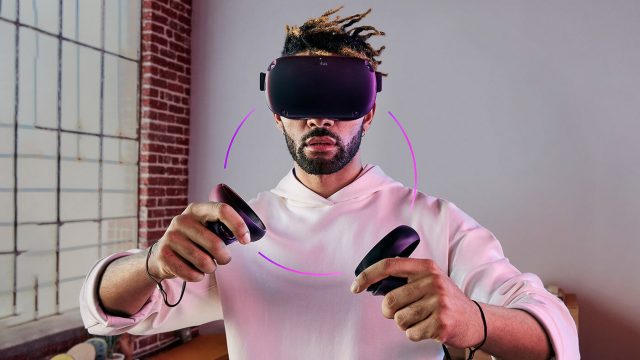Oculus Quest Getting Controller-Free Native Hand-Tracking This Week
Last week, Facebook’s Oculus Quest headset got a USB-C tethering that enables it to run the more powerful Rift apps. This week, it is set to get a new feature- native hand tracking, that will enable it to work without controllers. Instead, it will rely on the headset’s external cameras to track hand movement and finger motion.

The Oculus Quest headset owners have a reason to smile this week as the standalone virtual reality headset is set to get native hand-tracking support this week. Oculus made this announcement on Monday. Hand tracking functionality will enable the headset owns to navigate and control the headset apps using only their hands without needing to use controllers. The initial rollout of the feature will however be limited.
Oculus has stated that the hand-tracking support for Quest is “an early consumer feature” which will be rolled to developers from next week. During the initial release, Quest owners will be able to use their hands to navigate and interact within Oculus Quest’s Home interfaces such as the Library and Store as well as in the select first-party apps such as Oculus TV and Oculus Browser. Quest owners will even be able to set their floor height for stationary Guardian boundary using their hands without the need for a controller. Oculus has said this will just be the beginning and the company is planning to roll out new features that will help improve the experience of hand tracking on Oculus Quest in 2020.
From next week, developers will get the option of building “controller-free hand interactions in Quest apps for the first time” according to Oculus. Oculus is, however, tempering the expectations about the proposed hand-tracking support and says the hand-tracking will offer support for everything from the more expressive gestures in social apps to the efficient workflows in business training modules and much more. Oculus expects the first third-party apps to launch in 2020.
The native hand tracking support for Quest was initially expected to arrive in 2020 but it will now come as experimental feature in the software version v12 in the next few days. After the update has been installed, users can activate the hand tracking in the “Experimental Features” menu. They will subsequently be able to switch between the Touch controllers and the hand tracking using the toggle switch in the Oculus Home menu.
Support for hand tracking during launch will be somewhat limited. For now, only the Library and Store interfaces on the Oculus browser as well as Oculus TV apps will work. Next week, the developer toolset for hand tracking for app makers will be released. After that, expect support for many of the current games and apps to roll out a few weeks down the line.
Hand tracking is an augmented reality and virtual reality trend that is expected to grow in the coming years. This will particularly be the case with Qualcomm’s next-generation AR and VR chips that promise to deliver better hand and face tracking headsets in 2020.
https://virtualrealitytimes.com/2019/12/10/oculus-quest-getting-controller-free-native-hand-tracking-this-week/https://virtualrealitytimes.com/wp-content/uploads/2019/03/Oculus-Sets-a-High-Quality-Bar-for-Quest-Content-600x338.jpghttps://virtualrealitytimes.com/wp-content/uploads/2019/03/Oculus-Sets-a-High-Quality-Bar-for-Quest-Content-150x90.jpgHardwareOculus QuestVR HeadsetsLast week, Facebook’s Oculus Quest headset got a USB-C tethering that enables it to run the more powerful Rift apps. This week, it is set to get a new feature- native hand tracking, that will enable it to work without controllers. Instead, it will rely on the headset’s external...Sam OchanjiSam Ochanji[email protected]SubscriberVirtual Reality Times - Metaverse & VR
